617 Search Results for tell me about it
February 9, 2013
by Robin Parker -
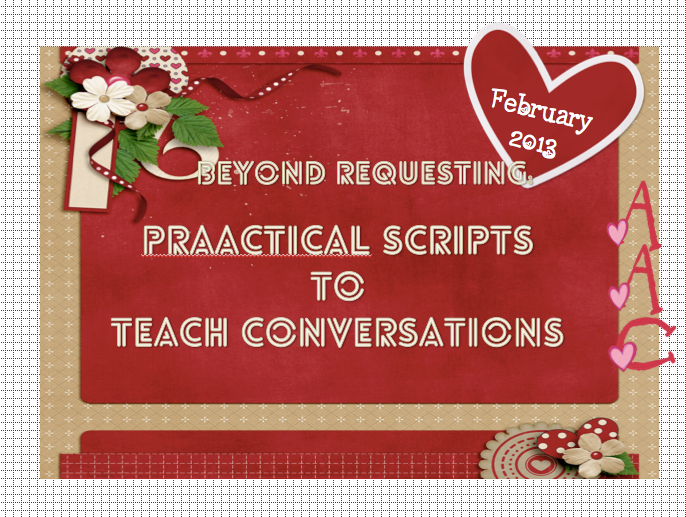
This month’s communication and language strategy goes beyond requesting into conversation. Beginning (and more advanced) communicators can be introduced to conversations through scripts. Scripts for teaching the art of conversation can help give the language to initiate, maintain, extend, and terminate social and conversational exchanges. Scripts can be used to talk about special interests, to participate in activities, and much more. When we teach scripts in a way a learner ‘learns’, the script shows the guidelines, boundaries, and organization of conversations. The communication and language goal is conversation. The strategy to teach conversation is scripts. Scripts are not that foreign to the conversational situation. We all may use scripts at times. Think about your ‘small talk’ scripts or your scripts that help you in unfamiliar or difficult conversations. If learners have difficulty knowing how to participate in conversation, a script can capitalize on strengths like memory and doing well with... [Read More...]
February 2, 2013
by Carole Zangari -
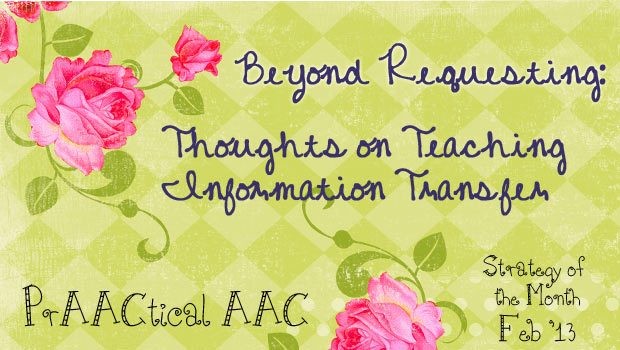
Although it has been close to 25 years since Dr. Janice Light’s hallmark paper on communicative competence in AAC discussed four main purposes of communication, many AAC systems are still heavily populated with messages for basic wants and needs. The other areas – information transfer, social closeness, social etiquette – are often underrepresented in AAC systems. We scratched the surface of how to teach basic requesting last month, and now we’re ready to talk about communicating for other reasons. In this post, we’ll talk about some of the clinical issues in teaching communication for the purpose of information transfer. A big reason that we express ourselves is to share information that others want or need. It may not seem like a high priority until we realize how often we need to do this to function in our daily lives. Here are some examples, both positive and negative, from our work... [Read More...]
January 30, 2013
by Robin Parker -
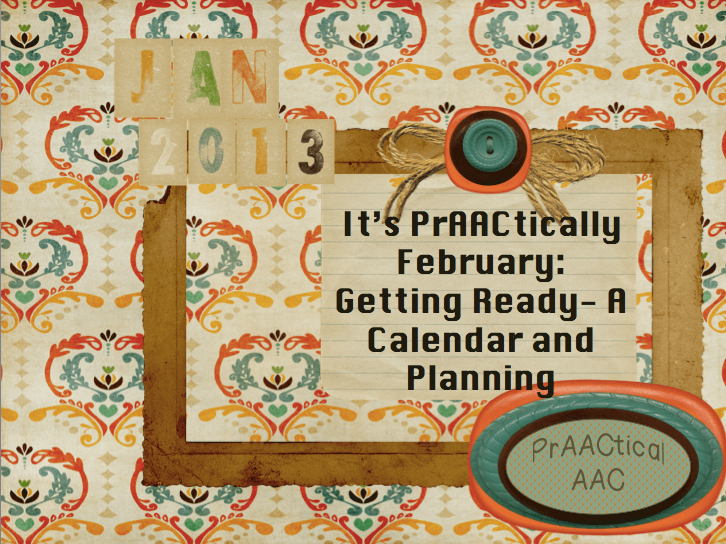
January is (was) a fairly crazy and busy month for us. After a late back to school week, the CARD Conference, the Dan Marino Foundation WalkAbout Autism, and ATIA Conference (hope to see you there), we got a bit of a late start on a few things. To stay ahead of ourselves, we want to end January by being ready for February…… For February, we have a calendar for incorporating AAC into everyday activities (it goes with yesterday’s post 28 things to do). Feel free to print out and share and use anyway you want to promote PrAACtical AAC. A PDF version (free) can be found at our Teachers Pay Teachers site. Our new Strategy of the Month (on Saturday) will focus on Communication & Language Beyond Requesting. There are no pre-requisites to learning and being immersed in ALL of the reasons to communicate (communication functions). For some learners, it... [Read More...]
January 29, 2013
by Robin Parker -
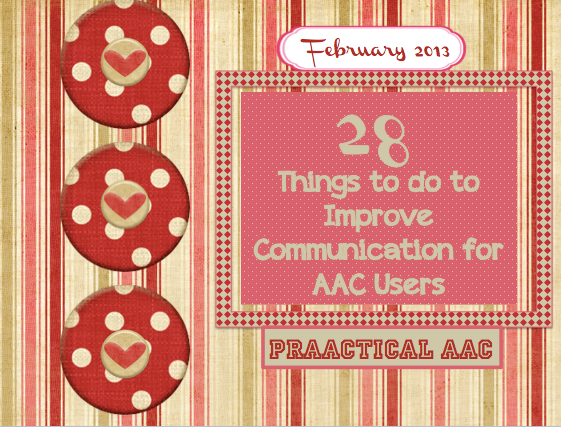
It’s almost February and and we were thinking about ways to encourage communication in a fun and meaningful way for the whole month. The best way we know is to build a visual language environment by providing lots of AAC modeling (Aided Language Input-ALI) and by using lots of visual supports. Here are some ideas to expand opportunities and/or to get started. We would love to know what works, what doesn’t, and any other ways you build visual language into everyday experiences. Use Aided Language Input (ALI) to say ‘I Love You’ . Make it part of a routine Offer learners a book choice board/choice book when deciding what book to read in speech-language therapy/classroom/home Use Aided Language Input (ALI) to tell how you feel when something is hard or difficult for you Use a ‘stop sign’ symbol to indicate an off limit area Use Aided Language Input (ALI) to... [Read More...]
January 28, 2013
by Robin Parker -
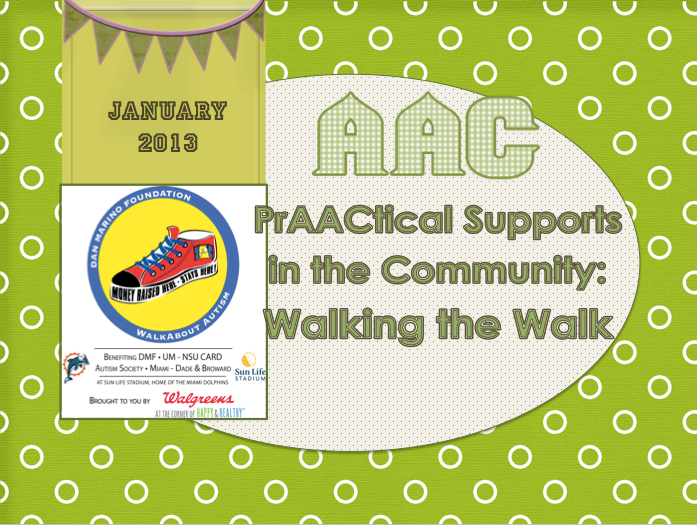
We are extremely proud to be part of the Dan Marino Foundation WalkAbout Autism, which is a large South Florida event. It is a true collaboration between the community, volunteers, sponsors, donors, walk partners, and the Miami Dolphins. The Walkabout helps raise money for organizations that provide programs and services for individuals with autism and other developmental disabilities. It also promotes a sense of community collaboration and awareness about autism spectrum disorder and developmental disabilities. We are writing about the WalkAbout, not as a plea for money (although read about the WalkAbout and donate if you are so inclined), but instead to tell you how we continue to try to integrate AAC & visual strategies into community events. We are so grateful to Dan & Claire Marino and their family and Jeff & Rachel Ireland and their family for continuing to dedicate their time and effort for this amazing event. This past weekend was the 3rd WalkAbout Autism. It was a... [Read More...]
January 26, 2013
by Carole Zangari -
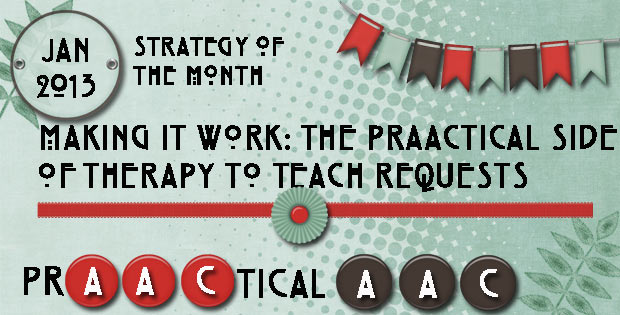
This month we’ve been talking about requesting and choicemaking, specifically how to teach it. Today, we’ll put it into a clinical context by talking about a hypothetical session that targets this skill, but also highlights other strategies. As you read about the materials, preparation, and script, look for how they incorporate strategies such as building specific communication opportunities {CO}, aided language input {ALI}, and expansions {EX}. The clinician also builds in repetition with variety so that there is sufficient opportunities for teaching and practice using multiple modes of communication. In this scenario, you’ll meet Jenna, a 5 year old with significant language difficulties secondary to Cri du Chat syndrome. Jenna’s communication system includes about a dozen manual signs (SIGN), 20-25 word approximations (SPEECH), a few gestures (GEST), some manual communication boards (COMM BD), and an iPad with a full-featured AAC app (iPAD). She also uses movement (MOVEMT), vocalizations (VOC), and... [Read More...]
January 23, 2013
by Carole Zangari -
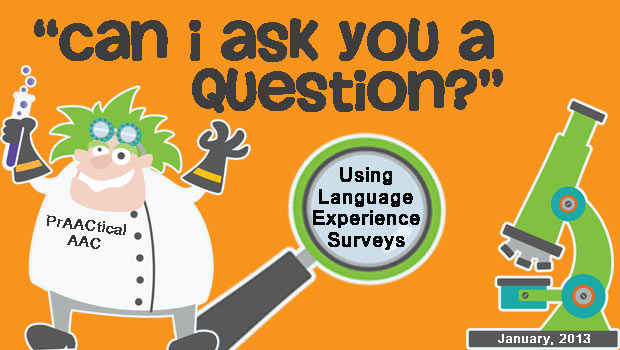
Want to give your AAC learners more frequent opportunities to interact with others? We love using Language Experience Surveys for this purpose. The concept is a simple one. Once you have a language goal in mind, craft a survey with a key question that the communicator can use as a conversation starter. After some instruction and practice, they can then ask people the question. You’ll need to create visual supports for the survey so that the communicator can use it as a cue and show to the interaction partners. In some surveys, the partners then use the visual support to record their responses. Putting the visual support on a clipboard works well in some situations. The simplest way to do this is with a forced-choice question with a list of response options. The survey could be about favorite TV shows or places to visit, for example, and show different options.... [Read More...]
January 16, 2013
by Robin Parker -
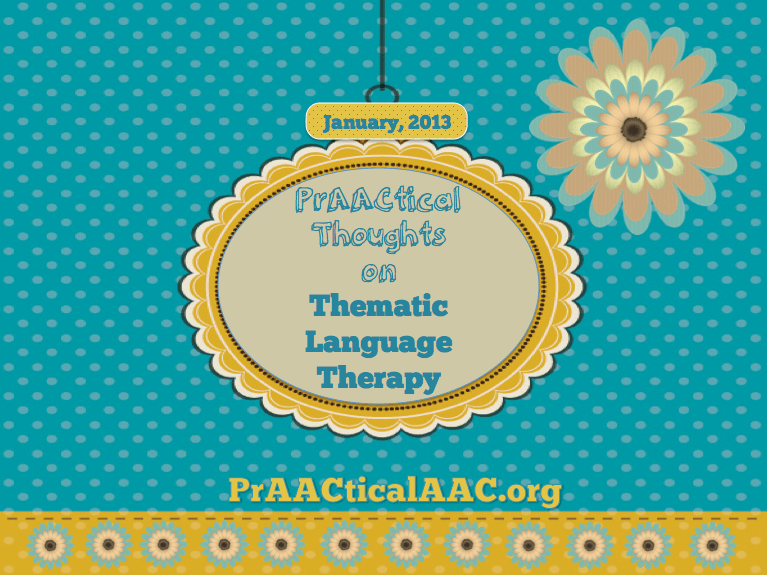
Thematic language therapy can be part of a meaningful language experience. This is true for everyone but especially helpful for learners with social communication/language difficulties. The theme of a session or theme of a month (or semester) can help a learner understand the relationship of individual activities to a larger main idea. For some learners it is easier to understand the details than to understand the ‘big picture’. By adding well thought out thematic features in intervention, the learner can then have many opportunities to relate the component parts of a theme to a main topic. Another aspect and benefit of thematic language learning has to do with word, concept, & vocabulary access. If a theme is used in a variety (or ALL) activities, there is a greater chance that the learner will be using similar words and concepts in talking, listening, reading and writing. By using all language modalities, vocabulary, word... [Read More...]
January 10, 2013
by Carole Zangari -
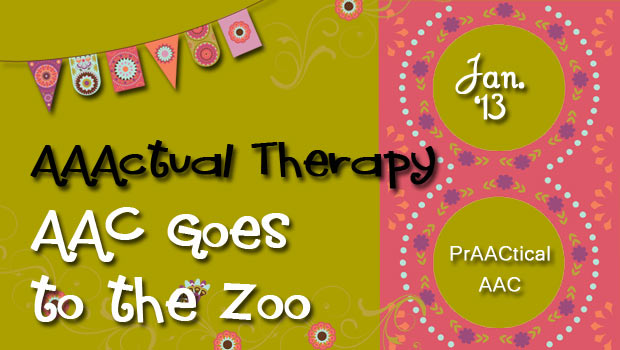
Welcome to AACtual Therapy, a new series on PrAACtical AAC that we’re undertaking in order to give you an up-close-and-personal look at SLPs who ‘do’ AAC. Each of these posts will feature one of our prAACtical friends, some of whom have been AAC interventionists for awhile and others who have come to it more recently. Each one is passionate about giving people a voice no matter what their age or ability level. They’ll be giving us a peek into an AAC therapy lesson that they use, and telling us about the strategies that make it successful. They’ll share a bit about the goals and objectives the lesson was designed to address, and what sorts of AAC their clients are using. Hopefully, we’ll see them in action Here’s what NOT to expect: Perfection. It doesn’t exist, so we don’t even bother looking for it. We’re featuring these clinicians because we want... [Read More...]
December 22, 2012
by Robin Parker -
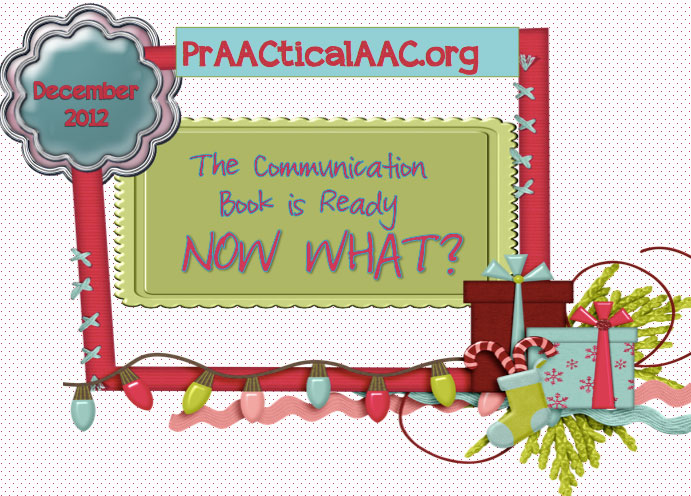
The Communication Book is Ready… Now What? The fun begins…. Yes, we really do think that TEACHING a learner to USE the communication book is FUN. We get to participate in lots of meaningful language experiences, we get to be creative, we get to watch language blossom, and we get to be surprised by the communication competence ALL of our learners show us after prAACtice, prAACtice, and for some more prAACtice . The best way to get started with communication book teaching is to begin by trying out different teaching tips, strategies, and resources and find out what works best. Each communication dyad (communicator & communication partner) is different so the combination of strategies that will work will vary but at the core of the teaching process, there should be fun, motivation, and of course progress. STRATEGIES and CONSIDERATIONS Aided Language Input (ALI)– We can not say enough about... [Read More...]









